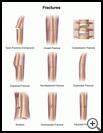
Setting a Broken Bone Without Surgery (Closed Reduction)
What is closed reduction?
Closed reduction is a procedure for putting the pieces of a broken bone back into the right position without surgery.
When is it used?
Your healthcare provider may use this method if:
- Your bone is broken in 1 place and the pieces of bone have not gone through the skin.
- You don’t need plates, pins, or screws to help hold the pieces of bone in place.
How do I prepare for this procedure?
This procedure is usually done soon after you break the bone. Your healthcare provider will talk about your choices for treatment and explain the procedure and any risks. Ask any questions you have before the procedure. You should understand what your healthcare provider is going to do. You have the right to make decisions about your healthcare and to give permission for any tests or procedures.
Tell your healthcare provider if you have any food, medicine, or other allergies such as latex. Also tell your provider when you last ate or drank anything and about all medicines and supplements that you take.
Find someone to give you a ride home after the procedure.
What happens during the procedure?
You will be given medicine called anesthesia to keep you from feeling pain. Depending on the medicine, you may be awake or asleep during the procedure.
Your healthcare provider will move the pieces of broken bone into a position where the bone can heal properly. Your provider may then put a cast or splint on the broken bone to keep the pieces of bone in place.
What happens after the procedure?
After the procedure you may stay in a recovery area for an hour or more. Depending on how bad your injury is, you may stay in the hospital for a few days or you may go home the same day.
Your provider may give you instructions to follow after the procedure. They may include:
- Taking medicines to relieve pain, prevent infection, or treat other problems
- Raising the injured area above your heart to help reduce swelling
- Avoiding some activities for a while
- Symptoms or problems to watch for and what to do if you have them
- When you can return to your normal activities
- When to come back for a checkup
What are the risks of this procedure?
Every procedure or treatment has risks. Some possible risks of this procedure include:
- You may have problems from the anesthesia.
- The procedure may not work and you may need surgery to repair the broken bone.
- The bone may grow back together in a different way than it was before the fracture. It may not be perfectly straight.
- You may have bleeding or blood clots.
- Joints, nerves, tendons, or blood vessels in the area may be damaged during the procedure.
Ask your healthcare provider how the risks apply to you. Be sure to discuss any other questions or concerns that you may have.

